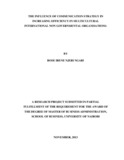| dc.contributor.author | Ngari, Rose Irene Njeri | |
| dc.date.accessioned | 2013-11-18T08:56:06Z | |
| dc.date.available | 2013-11-18T08:56:06Z | |
| dc.date.issued | 2013-11 | |
| dc.identifier.citation | Master Of Business Administration, University Of Nairobi, 2013. | en |
| dc.identifier.uri | http://erepository.uonbi.ac.ke:8080/xmlui/handle/123456789/59229 | |
| dc.description.abstract | There have been contradictory findings of the empirical studies that have left a research
gap on communication strategy in increasing efficiency in Multi-cultural International
Non Governmental Organizations. The ability to comprehend communication quickly and
accurately then appropriately and effectively engage persons from distinct cultural
backgrounds to attain the desired effect despite the lack of familiarity with other cultures
helps build relationships with foreigners in the organizations hence the success of their
existence. This study attempted to investigate the influence of communication strategy in
increasing efficiency in multicultural international NGOs. The findings also provided
insight to the NGOs that are cautious on implementation of these strategies as well as
providing the most suitable styles of communication that need to be applied. The Non
Governmental Organizations are perceived as being motivated to achieve a common
understanding thus the study was hinged on the premise that by conceiving cultural
differences and language as the main barriers for intercultural communication, learning
about the other cultures is a remedy for many misunderstandings that are experienced.
This study is based on one main objective. The study is based on the social constructivist
view that implies the norms which guide strategy are cultural as opposed to cognitive. The
researcher used cross sectional research design. This involved collection of standardized
information from the population under study. The researcher opted to use the survey
design as it is the most appropriate for this study offering the advantage of producing
comparable information across the surveyed population and also it is considered useful
when dealing with a large population, giving a cross sectional picture of the phenomenon.
The target population for this study was one hundred and ninety two (192) Multicultural
International Non Governmental Organizations based in Kenya. The research adopted a
survey whereby out of the focus population of study who were given questionnaires
mainly through electronic mail and a few visits made in search for respondents and follow
the results was that , One hundred and ten were filled and returned for the researchers’
analysis. Primary data was collected for this study. The research method used was both
qualitative and quantitative. The conclusions drawn from the research were that where
there was no training, cultural communication was perceived by employees in the course
of their work through personal training. Cross cultural communication can also be
managed through personal experience during personal interaction with the clients in the
course of the work. Employees can learn in the course of their work through interacting
with the locals and this could help achieve efficiency in the organization. The
recommendations for the study were that the management of the Non Governmental
organizations should consider employing more young people to bring in more fresh and
new ideas to ensure growth and efficiency in the organizations. Information flow should
be prioritized and enhanced in the organization to ensure that communication barriers are
limited. They should also have forums to educate employees on languages where cross
cultural communications is prevalent as well as engaging intermediaries who are familiar
with both cultures so that they can translate both the substance and manner of what was
communicated. | en |
| dc.language.iso | en | en |
| dc.publisher | University of Nairobi | en |
| dc.title | The Influence Of Communication Strategy In Increasing Efficiency In Multicultural International Non Governmental Organisations | en |
| dc.type | Thesis | en |
| local.publisher | College of Humanities and Social Sciences | en |

